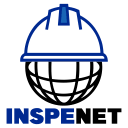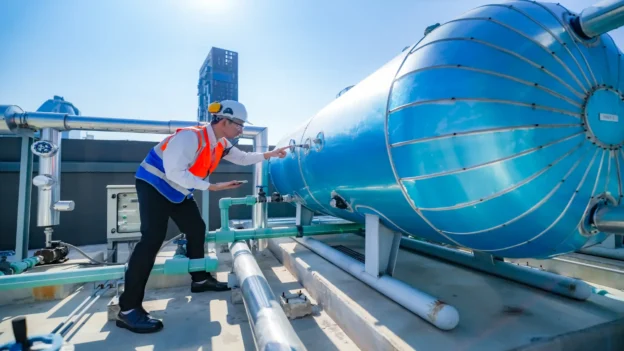Table of Contents
Pressure vessels are indispensable equipment in the operation of numerous industrial processes, especially in sectors such as petrochemicals, oil and gas, energy, mining, pharmaceuticals and food. Their ability to contain fluids under high pressures allows them to perform tasks such as storage, separation, chemical reactions, and flow regulation.
Due to their presence in systems where efficiency and operational safety are a priority, it is essential to understand their classification, function, design, and the regulations that govern their integrity throughout their life cycle.
What is a pressure vessel and what is it used for?
It is a closed equipment designed to store gases or liquids at an internal pressure different from atmospheric pressure. Its application is extensive: in chemical plants, refineries, power generation, and industrial refrigeration systems. This equipment can withstand internal or external pressures, and must be designed to avoid failures that could be catastrophic. The materials of manufacture, structural design, and type of fluid contained are essential factors for their technical specification.
Pressure vessels enable processes such as controlled chemical reaction, phase separation, industrial gas storage, and energy storage. Equipment such as reactors and distillation columns, spheres, phase separators, drums, and accumulators represent typical examples of their use.
Classification of pressure vessels
The classification of pressure vessels responds to criteria of geometry, orientation, design pressure and function in industrial processes. Understanding this classification allows optimizing their selection, design, and operation.
1. Types of pressure vessels according to geometry and orientation
- Horizontal cylindrical: Used for storage and transportation, especially of liquefied gas and fuels.
- Vertical cylindrical: Common in separation or reaction systems, such as distillation towers.
- Spheres: Designed to contain large volumes of gases at high pressure, their shape minimizes internal stresses.
- Conical and elliptical: Geometries used to facilitate fluid movement or sedimentation.
2. Types of pressure vessels according to design pressure
- Low pressure (<1 barg): Typical in refrigeration systems or condensers.
- Medium pressure (1-40 barg): Common in standard industrial processes.
- High pressure (>40 barg): Used in critical reactions or storage of gases such as hydrogen.
3. Types of pressure vessels according to their function in industrial processes
- Phase separators: Allow liquid-liquid, gas-liquid or solid-liquid separation.
- Reactors: Facilitate chemical reactions under controlled conditions of pressure and temperature.
- Distillation columns: Used for fractionation of liquid mixtures.
- Accumulators or drums: Store or buffer fluid flow to avoid pressure peaks.
Applicable codes and regulations
One of the important aspects in pressure vessel engineering is the application of codes and regulations that guarantee safety, quality, and reliability during the design, manufacture, inspection, and operation of this equipment. Among these regulatory frameworks, the following stand out as the most widely used and internationally recognized:
1. ASME Boiler and Pressure Vessel Code (BPVC)
Establishes the technical criteria necessary to ensure the integrity of boilers and pressure vessels. In particular, Section VIII of the code regulates pressure vessels, addressing aspects such as:
- Structural design requirements (based on allowable or limit stresses)
- Selection of materials and traceability
- Types of joints and manufacturing methods
- Inspections by non-destructive testing (NDT)
- Certification by authorized bodies
This section is divided into three divisions, each oriented to different pressure ranges and complexity:
- Division 1: Applicable to general vessel design at moderate pressures
- Division 2: Provides a more rigorous and detailed design approach, allowing for more optimized and efficient structures.
- Division 3: Targets ultra-high pressure vessels, typically in excess of 700 bar (approx. 10,000 psi).
This code has been adopted as a legal reference or technical standard in many countries, becoming a global standard for the manufacture and inspection of pressure vessels. Its compliance supports the certification and acceptance of equipment in international markets.
2. API 510 (Pressure Vessel Inspection Code):
It is another standard issued by the American Petroleum Institute. It regulates the inspection, repair, alteration, and re-certification of pressure vessels in service. It is mainly applied in industries such as petrochemical and oil, where the risks associated with structural failures are high. This code complements the ASME Boiler and Pressure Vessel Code by addressing the complete equipment life cycle.
Pressure vessel Inspection
Periodic inspection allows the identification of defects before they lead to critical failures. Methods employed include:
- Non-destructive testing (NDT): conventional ultrasonic or phased array (PAUT), radiography, liquid penetrant, magnetic particle, acoustic emission
- Pressure testing: hydrostatic or pneumatic.
- Internal and external visual inspection supported with Drones and 3D scanners
API 510 and NBIC (National Board Inspection Code) standards establish the intervals, acceptance criteria, and inspection requirements, depending on the type of fluid, pressure, and criticality of the service.
Pressure vessel certifications
Pressure vessel design, manufacturing, and repair certifications ensure that equipment complies with safety, reliability, and quality standards in different markets. Below is a table indicating the standards, applications, and requirements
Pressure vessel certification table
| Standard / Certification | Issuing Entity / Jurisdiction | Application | Requirements / Comments |
|---|---|---|---|
| ASME Section VIII (Div. 1, 2, 3) | ASME (USA) | Design, fabrication, inspection, and testing | Must bear the ASME U (Div. 1), U2 (Div. 2), or U3 (Div. 3) stamp. Only authorized manufacturers may apply the stamp. |
| NB (National Board Registration) | National Board (USA) | Post-fabrication registration | Equipment must be built according to ASME standards and registered with the National Board with an NB nameplate. |
| R Stamp | National Board (USA) | Repair or alteration | Companies must be certified to perform repairs under NBIC (National Board Inspection Code). |
| PED 2014/68/EU | European Union | Equipment for the European market | Requires CE marking, conformity assessment, and technical documentation. |
| ISO 11120 / ISO 16528-1 | ISO (International) | Seamless vessels and general approval | Primarily applies to international design systems and conformity assessment processes. |
Inspection personnel certifications
Pressure vessel inspection is an activity that demands hands-on experience and a solid technical background backed by internationally recognized certifications. These credentials ensure that personnel responsible for assessing the mechanical integrity of equipment have the necessary skills to interpret codes such as ASME Section VIII, apply NDT techniques, identify failures, and make valid judgments during regulatory audits or structural repairs.
The following are the main certifications required or recommended for pressure vessel inspector.
Pressure vessel inspector certification charts
| Certification | Issuing Entity / Jurisdiction | Scope | Comments |
|---|---|---|---|
| API 510 – Pressure Vessel Inspector | API (USA) | In-service inspection | Includes knowledge of ASME VIII design, MAWP assessment, NDT, testing, and repairs. Valid for 3 years. |
| AI – Authorized Inspector | National Board (USA) | ASME construction and repair inspection | Must work for an authorized entity and complete official NB training. |
| NDT Level II / III Inspector | SNT-TC-1A (ASNT) / ISO 9712 | Non-destructive testing | Level II: performance. Level III: supervision and procedure design. Methods include PT, MT, UT, RT, etc. |
Documentary traceability
It is an essential requirement in the manufacture, inspection, and operation of pressure vessels, especially if they are regulated by the ASME Section VIII code. This process allows precise identification of each equipment component, from the origin of the materials to the welding records, non-destructive tests, inspections, and final certifications.
Well-organized, traceable documentation facilitates audits and regulatory validations, as well as supports the operational reliability of the equipment throughout its life cycle. In industries where safety and legal liability are critical, the absence of traceability represents an unacceptable technical and administrative risk.
The table below details the main elements that must be documented and traceable during the life cycle of a pressure vessel:
Table on traceability documentation for pressure vessels
| Stage | Document / Record | Purpose / Observations |
| Design | – Design calculations according to ASME VIII / PED / ISO 16528-1 – Certified fabrication drawings | Verifies compliance with standards, design pressure, wall thicknesses, and geometric configuration. |
| Materials | – Material conformity certificates (EN 10204 3.1 / 3.2) – Traceability by heat or batch number | Ensures the quality of steel, alloys, and welds used. |
| Fabrication | – WPS, PQR, and WPQ (qualification of welding procedures and welders) – Weld maps and traceability records – NDT records (PT, UT, RT, etc.) – Hydro/pneumatic tests | Certifies that the vessel was built according to qualified procedures and properly tested. |
| Initial inspection | – Report by Authorized Inspector (AI / API 510) – Final ASME or CE (PED) acceptance certificate | Safety validation document prior to operation. |
| Operation & maintenance | – API 510 periodic inspection records – Operating log and maximum pressure records – Preventive / corrective maintenance log | Helps verify continued operation under safe conditions. |
| Repairs / modifications | – Technical repair report – NB “R” Stamp authorization (if applicable) – Post-repair NDT results – MAWP re-evaluation report | Ensures any intervention maintains conformity and structural safety. |
| Legal documentation | – Registration with national authority (e.g., National Board, INMETRO, STPS) – Declaration of Conformity – User manual / O&M manual | Required by local authorities or for external audits. |
Risks associated with pressure vessels
Throughout industrial history, multiple accidents have been associated with pressure vessel failures, from overpressure explosions to toxic gas leaks. The most common causes include overpressure, corrosion, manufacturing defects, weld failures, and poor operating or maintenance practices.
Failure prevention requires a comprehensive approach that addresses all stages of the equipment life cycle:
- Design: Governed by standards such as ASME Section VIII, which establish requirements for mechanical strength, welding, fatigue, and material compatibility.
- Materials: Selected according to operating conditions, with emphasis on corrosion resistance and weldability.
- Construction: Under standards such as NBIC and ASME, with traceability, material certification, and non-destructive testing.
- Maintenance: Preventive, predictive, and corrective, with rigorous technical documentation to evaluate the integrity of the equipment over time.
Proper management of these factors reduces the risk of catastrophic failures, protects personnel and the environment, and extends the useful life of the equipment.
Importance of life cycle management
The safe operation of a pressure vessel does not depend only on its initial design. Periodic inspection, API 510 compliance, and predictive maintenance ensure structural integrity over time. In addition, proper documentation and traceability, as well as certification of welders and procedures, are part of a comprehensive asset management strategy.
Conclusion
Understanding the classification of pressure vessels, their industrial function, and strict compliance with standards such as ASME Section VIII and API 510, are a guarantee for the safety and operational efficiency of your pressure vessel. Proper design, personnel certification, and the application of advanced inspection technologies ensure a longer and more reliable life cycle.
References
- ASME (American Society of Mechanical Engineers) (2021). ASME Boiler and Pressure Vessel Code, Section VIII: Rules for Construction of Pressure Vessels (Divisions 1, 2 and 3). ASME.
- API (American Petroleum Institute) (2022). API 510: Pressure Vessel Inspection Code – In-service Inspection, Rating, Repair, and Alteration (11th ed) API.


